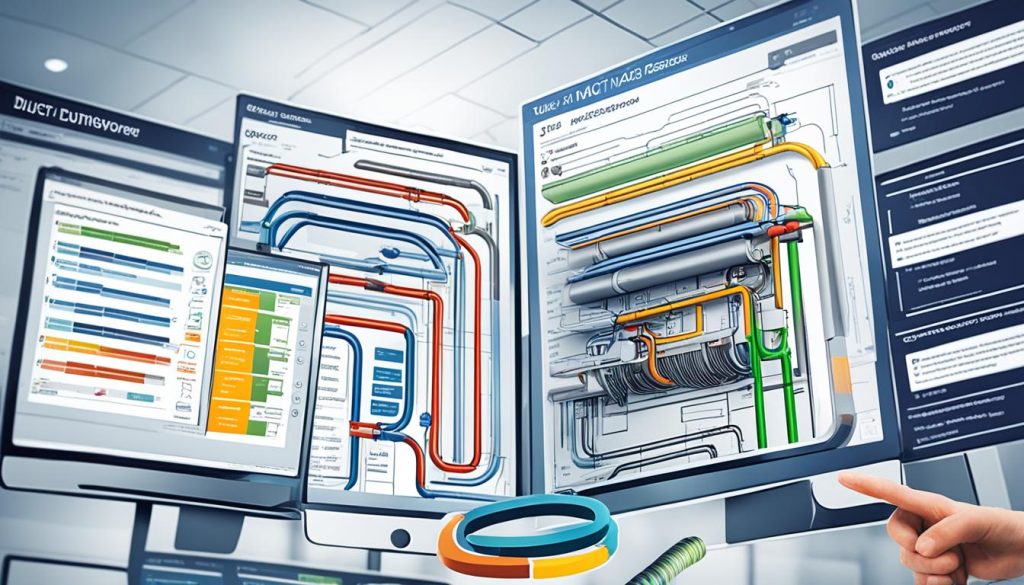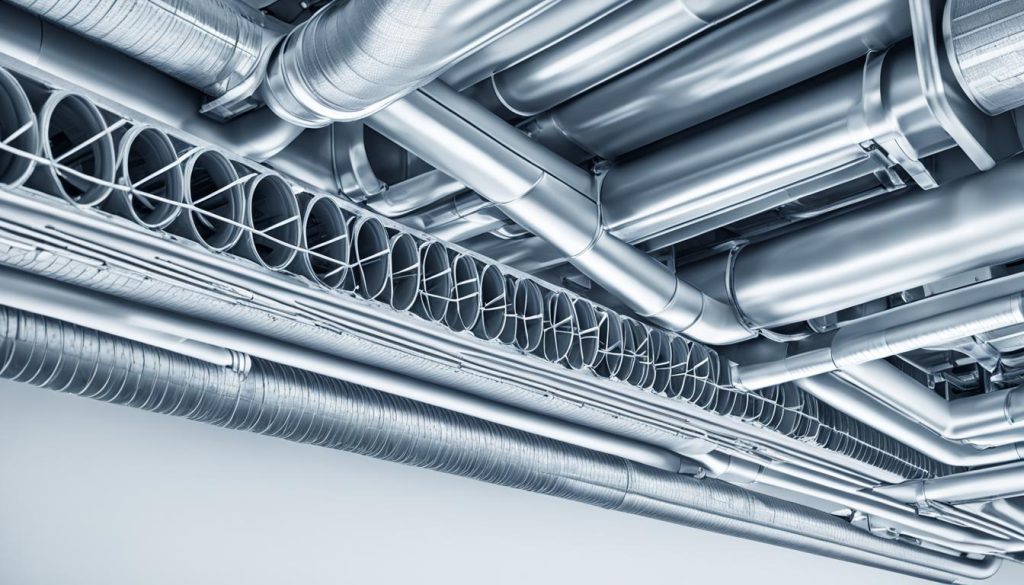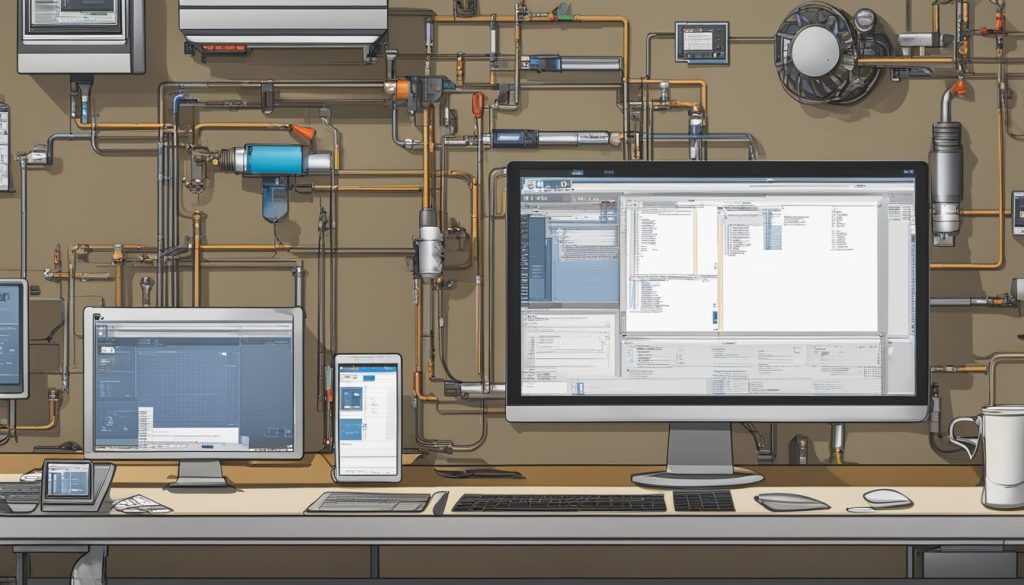The Duct Design Software Guide is essential for HVAC pros working on duct systems. It delves into software tools for making duct design easier. These tools help ensure accurate models, good air, and energy savings.
Key Takeaways
- Comprehensive guide tailored for HVAC professionals.
- Highlights various advanced ductwork design programs.
- Ensures optimal performance and air quality.
- Supports energy-efficient designs.
- Adheres to industry standards.
Introduction to Duct Design Software
Today, the HVAC industry is growing fast. The top duct design software is key to making better designs faster. It’s a must-have for HVAC experts working on projects that need to meet high standards. This includes work on homes and buildings we use every day.
Learning about HVAC duct design tools starts with the introduction to duct design programs. These programs do a lot. They can quickly figure out the best duct sizes and make great 3D models. This makes work speedier and more precise.
The best duct design software helps model new and old systems carefully. It’s built for experts to deal with today’s complicated ductwork jobs. It focuses on saving energy and following strict rules.
Also, these tools can guess the materials and costs needed for projects. They look at everything from the start to the end of the job. That makes them a full solution for ductwork design.
Now, let’s look at what these tools can do:
| Functionality | Description |
|---|---|
| Automated Calculations | Quickly find the best duct sizes and layouts. |
| 3D Modeling | See and change the duct system design in 3D. |
| Material and Cost Estimations | Estimate materials and what the project will cost accurately. |
| Compliance Checks | Make sure designs meet rules and standards. |
In the end, using the best duct design software makes HVAC projects better. These HVAC duct design tools help pros make ductwork that’s efficient, cheap, and follows rules. They are essential for any HVAC expert.
Types of Duct Design Software
Designing HVAC duct systems has various software for different needs. You have tools for simple duct sizing to full solutions for detailed analysis and better designs.

The top tool is the VariTrane Duct Designer. It works for homes and businesses. It.auto balances ducts and makes material lists. It’s user-friendly, accurate, and meets all standards.
SimScale’s CFD Analysis is for big simulation tasks. It’s great for fluid flow checks and finding pressure loss. This makes it perfect for tricky commercial duct designs.
Then there’s Ductsize software for sizing ducts just right. It uses different methods and fits well with AutoCAD. Great for any project, it lets you see and change designs easily.
Each top tool offers something special. They help pros choose the best software for duct designs. This means more efficient projects, whether for homes or businesses.
Key Features of HVAC Duct Design Software
HVAC duct design software is key in modern ductwork jobs. It boosts design accuracy and workflow efficiency. These tools solve complex issues, make design processes smoother, and save on HVAC project costs.
Automated Calculations
Automated calculations are a main feature in HVAC duct design. They quickly find the best shapes, sizes, and layouts for ducts, reduce pressure losses. Automated calculations make your designs efficient and meet standards, cutting out manual work and mistakes.
3D Design Capabilities
3D design is great for seeing your duct system clearly. This makes problems easy to spot and helps tweak designs for better performance. With 3D design, HVAC experts can test layouts before making them real, for the best final ductwork.
Material and Cost Estimations
Getting material costs right is vital for HVAC projects. HVAC duct design software is excellent here. It estimates material and cost details exactly, letting designers plan their budgets well. This helps pick the best-priced materials without losing on quality.
Choosing the Best Duct Design Software for Your Needs
When picking guide to selecting HVAC software, ease of use is critical. You should also look at the features it offers and if it works with your current systems. Knowing what each option provides helps pick the right one for your project.

VariTrane Duct Designer is great for projects needing flexibility and detailed analysis. On the other hand, SimScale is best when you need to analyze complex duct setups with CFD.
Ductsize is a top choice for meeting ASHRAE and SMACNA standards, important for professional and compliant projects.
- Ease of Use: Ensure the software is user-friendly and intuitive.
- Feature Rich: Look for features that cater to both basic and advanced needs.
- Compatibility: It should integrate seamlessly with other tools and systems.
- Specific Project Requirements: Different projects may necessitate unique functions.
To find the right duct design programs, balance these points. It’s crucial for projects, whether they’re big or small. Be familiar with what software like VariTrane Duct Designer, SimScale, and Ductsize can do. This ensures you’re choosing the best software for your HVAC designs.
Top Duct Design Tools for Industrial and Residential Projects
In the HVAC world, picking the right software is key. We will look at three top tools—VaritTrane Duct Designer, SimScale CFD Analysis, and Ductsize software. They are known for their great work in all kinds of projects.

VaritTrane Duct Designer
The VaritTrane Duct Designer impresses with its wide-ranging model and size features. It’s great for engineers who need to sort out complex duct systems. The software shows what materials are needed too, which is perfect for any project.
SimScale CFD Analysis
SimScale CFD Analysis shines with its cloud-based simulations for fluid flow. It’s a big help in comparing and making duct design better early on. Plus, the software checks that designs meet all standards.
Ductsize Software
For figuring out duct sizes just right, Ductsize software is on top. It uses different methods to calculate duct dimensions. It also works well with AutoCAD for clear project drawings.
Here is a look at what these top tools offer:
| Feature | VaritTrane Duct Designer | SimScale CFD Analysis | Ductsize Software |
|---|---|---|---|
| Modeling & Sizing | ✔ | ✔ | ✔ |
| Automated Calculations | ✔ | ✔ | ✔ |
| Material Listings | ✔ | ✖ | ✔ |
| Cloud-Based Simulations | ✖ | ✔ | ✖ |
| Integration with AutoCAD | ✔ | ✖ | ✔ |
How to Get Started with Duct Design Software
Starting with HVAC software needs a few basic steps to go smoothly. First, check if your system fits with the software’s needs. This prevents trouble later on.

After making sure your system is a match, start the installation. Follow instructions closely. This includes steps to install the duct design apps. Also, use tutorials and guides to understand the software better.
Learn the main terms and ways to use the duct design software. This helps you use advanced features later. So, you can use the software well.
- System Requirements: Before starting, check that your computer fits with the duct software.
- Installation: Follow the steps recommended by the software maker to install it.
- Learning Resources: Use tutorials and support guides to learn about the software.
- Familiarization: Know the basic terms and how to use the software for better project work.
Do these steps to smoothly start using HVAC software. This leads to good project planning and system setting. Being prepared is essential for effective duct design use in home and business projects.
For deeper understanding, look through detailed guides and join user forums. This offers useful tips and insights. It’s a great way to improve your skills with duct software.
Advantages of Using Duct Design Software
The benefits of HVAC design software are huge. They make planning and doing ductwork much easier and faster. Using these tools means you work with more precision and save time when designing.

One big advantage of duct software is that it helps avoid design mistakes. Tools like VariTrane Duct Designer, SimScale, and Ductsize have easy-to-use designs and strong features. This makes changing your designs quick and simple, helping them stay adaptable to any needs.
Plus, these programs create detailed reports to check your design’s accuracy. This check helps ensure your ductwork works well, saving on energy costs. It’s really important for making your designs efficient.
Here’s a comparison of some top duct design software:
| Software | Key Features |
|---|---|
| VariTrane Duct Designer | Automated balancing, material lists, error prevention |
| SimScale | Cloud-based simulations, fluid flow analysis, flexibility in alterations |
| Ductsize | Optimal duct sizing methods, AutoCAD integration, report generation |
Duct Design Software Guide for HVAC Professionals
Understanding HVAC duct design means knowing the importance of following the rules. It’s key for pros to use a top-notch software guide. This helps them stick to the right standards while making their work efficient.
Compliance with ACCA and ANSI Standards
HVAC experts must follow the rules from the Air Conditioning Contractors of America (ACCA) and the American National Standards Institute (ANSI). These rules ensure that ductwork is safe, works well, and lasts a long time. Using duct design software that includes these rules means pros can create designs that are safe, efficient, and meet all regulations.
Optimization Techniques
Getting duct design right relies on using the best software to analyze and improve. By using tools like SimScale, technicians can see how air moves and find ways to make it better. This lessens the loss of air pressure and boosts the system’s performance.
Software such as Ductsize also helps control costs by making accurate estimates. This means designs are not only top-notch but also budget-friendly.
To wrap it up, with the right software guide, HVAC pros can excel at their craft. They can meet the rules from ACCA and ANSI. Plus, they can use cutting-edge methods to make top-quality duct systems.





0 Comments